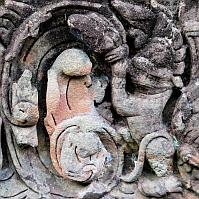
The German Ankorian Imagery Project
• G • A • I • P •
Krol Ko (pronounced "kraol ko") is a modern Khmer name of this small temple, it means "park of oxen". As it is only a smaller structure, Krol Ko is rarely visited, though it is right next to the Neak Pean car park at the Grand Tour road. Just opposite of the entrance and footbridge to Neak Pean, slightly to the northwest, you will easily recognize a laterite wall. It is the outer enclosure of the small Krol Ko temple.
The main entrance is from the east through a simple opening. A moat lined with steps surrounding the inner enclosure is still visible. The main court is defined by this 25 by 35 metres inner laterite wall. Its entrance is a Gopuram, now without roof. On the left side there is a so-called library building.
The principal temple is a Prasat with an eastern Mandapa-Hall. The ornamentation is in the Bayon style, some Devata sculptures in niches are well-preserved. Devatas are female divine guardians of sacred places. Devatas often occur in Hindu epics, but in some Buddhist scriptures, too.
Main attraction of Krol Ko are some bas reliefs of former pediments, they are reconstructed on the ground. Two of them on the right represent the Bodhisattva Lokesvhara, to whom the temple may have been dedicated. He is depicted on a lotus. Lokeshvara "World's Lord" is the most popular Southeast Asian variant of the Mahayana Buddhist saviour Avalokiteshvara. Other scattered stone carvings on the ground depict the Buddha in niches.
To the left is Krishna raising the mountain called Govardhana, in order to shelter the shepherds and their flocks from a thunderstorm sent by Indra. Interestingly, this is a Hindu subject in a Buddhist temple.
In general, Vishnu may be popular among Buddhists, but his Avatar Krishna is usually not venerated by them. The lifting of Govardhana is a topic from the Purana scriptures from early medieval times, when new Hindu believes prevailed in India. The Govardhana-subject indicates the superior power of Krishna over Indra. This is remarkable, as Indra is the supreme god in the ancient holy sciptures of India, the Vedas. In Buddhism those original vedic deities remained to be in higher esteem after Hindu worship in the early medieval periods shifted to Shiva, Durga, Vishnu and Krishna. Indra is often regarded and even venerated as a protector of the Buddhist faith, for example in Sri Lanka. All the more astonishing is the matter of fact, that Indra's inferiority to Krishna, who is venerated by Hindus only, is depicted at a Buddhist temple. It indicates a lack of rivalry between Brahmanism (Hinduism) and Buddhism in the Angkor civilization, whereas in India Buddhism was considered heretical by orthodox Hindus, because Buddhism did not recognize the religious signigicance of the cast system. But cast is an Indian concept, that was never fully adopted by the ancient Khmer and remained alien to most Southeast Asian civilizations.
As Krol Ko dates from the time of Jayavarman VII, it was a Mahayana Buddhist monastery. Probably it was connected to the nearby Neak Pean island sanctuary, which had no monks' abodes on its own, or to the large monastery complex Preah Khan.
Ernst Ando Sundermann
• G • A • I • P •
Copyright © 2021 khmer-heritage.de